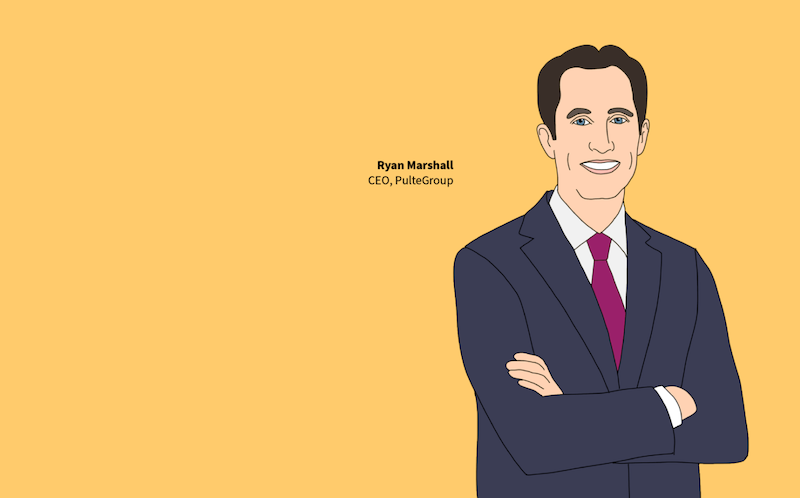Leadership
Pulte’s Margin Discipline Defies A Price War Among The Big 3
In Q2, Pulte bets on product mix and confidence-driven buyers. Margin-first strategy sets it apart from Lennar and D.R. Horton

In a home-selling environment as unforgiving as 2025, PulteGroup’s Q2 earnings show a company charting its path among the industry’s top three.
Where Lennar is pushing volume with aggressive incentives and D.R. Horton is leveraging scale to squeeze costs, Pulte is sticking to its guns: defend margins, lean on a higher-value product mix, and make every lot work harder.
Wolfe Research analyst Trevor Allinson’s post-call note puts it like this:
PHM continues posting industry-leading GMs as the company takes a thoughtful approach to price and pace. Management continues favoring price over pace in the current environment, given beliefs demand is relatively inelastic, especially regarding the company’s active adult and move-up consumer segments, whose buying decision is predicated on confidence while favoring location/product over monthly payment.”
Pulte’s strategy is built on the idea that not all demand is equal, and not all buyers can be coaxed with incentives alone.
Competitive Positioning: A Margin-First Playbook
Ryan Marshall, Pulte’s president and CEO, opened the Q2 earnings call with a clear statement of strategy:
Our diversified and balanced operating model offers strategic benefits to help sustain performance. In this competitive environment, we are reaping the advantages of being diversified across all buyer groups, particularly our industry-leading position in serving active adult buyers.”
While Lennar’s 13% incentive rate and volume-first “even-flow” construction dominate the headlines, Pulte kept incentives at 8.7% in Q2, up slightly from Q1, but nowhere near the discounting of its rivals. This discipline allowed Pulte to maintain gross margins at 27%, compared to Lennar’s 22.3% and Horton’s 21.8%.
Marshall made the contrast explicit:
There’s inelasticity in pricing, and more incentive doesn’t necessarily translate into incremental volume. That’s why we’ve tried to maintain discipline around the incentive load. I long for the days of more normal incentive loads of 3% to 3.5%.”
While net orders slipped 7.4% year-over-year, Pulte’s refusal to chase every sale is intentional. Active adult and move-up buyers—who make up the bulk of its sales—are less price-sensitive than entry-level customers and far more motivated by confidence and quality.
Land & Capital: Controlled, Not Choked
Lennar’s Millrose spin-off has made headlines as a model for asset-light risk control, but Pulte is carving its disciplined path. Pulte is steadily shifting toward a more asset-light model, but without the aggressive detachment of Lennar’s Millrose spin-off. CFO James Ossowski noted:
We have increased the total number of lots under control to approximately 250,000. We continue to make progress on becoming more land-light, as options now comprise 60% of our total land pipeline. This is gratifying progress toward our target of 70% options and 30% owned lots.”
Marshall explained the trade-off:
“The primary benefit we’re after with optionality is risk mitigation. Certainly, there is a trade-off. We give up a little bit of margin to get a better return, and we know that return is what creates value for our shareholders.”
The land pipeline—turned over roughly every 3.5 years—gives Pulte flexibility without locking it into pre-pandemic land cost structures. Wolfe Research notes that Pulte has largely depleted its pre-COVID land base, meaning its industry-leading margins aren’t being propped up by cheap legacy land. Instead, they are being earned through disciplined acquisition, product mix, and tight expense control.
Operational Excellence: Holding the Line on Costs
While Horton reported sequential reductions in stick-and-brick costs, Pulte’s costs held steady at $79 per square foot. Ossowski said:
The sticks and bricks were at $79 per square foot, consistent with last year and sequentially the same as Q1. So they're holding firm for us.”
Marshall credited the company’s purchasing teams:
Our procurement teams are the best in the business. They’ve done a wonderful job navigating another difficult procurement environment. I think we’ve also gotten a little bit of luck on our side with there being more inventory in the supply chain that has allowed prices to stay stable longer.”
The company is also tightening its build-cycle efficiency. Marshall highlighted off-site construction as a tool for speed and quality:
We’re getting a lot of benefit out of cycle time improvements with the amount of work that can be done ahead of time in a factory. We’re getting really good product quality, and it’s been an important part of our overall innovation work.”
Spec inventory, which spiked industry-wide in early 2024, is being reined in to 40–45% of overall units in production by year-end.
We’re balancing having enough units to meet higher demand while still allowing our sales counselors to sell from a position of strength,” said Ossowski.
Product Mix: Active Adult as a Shield
Active adult buyers—those who value lifestyle and community over a mortgage rate—are Pulte’s not-so-secret weapon. Del Webb orders climbed 9% in Q2 and accounted for nearly a quarter of total sales. These homes carry margins 400 basis points higher than entry-level Centex products and 200 basis points higher than move-up homes.
When you look at our three consumer groups, the entry-level, first-time buyer group is our lowest-margin performer. Move-up communities generate about 200 basis points higher, and we get an incremental 200 basis points out of the active adult communities,” Marshall explained.
This deliberate tilt toward higher-margin segments helps Pulte withstand competitive pressure, particularly in entry-level communities where Horton and Lennar dominate, where price wars are most intense.
Market Dynamics: Confidence as the Key Variable
If Lennar’s growth story is powered by incentives and Horton’s by scale, Pulte’s hinges on consumer confidence. Marshall was candid:
Feedback from would-be homebuyers indicates a variety of concerns, ranging from affordability and the inability to sell an existing home to a slowing economy and the fear of potentially losing their job. Consumer confidence is uncertain at best, and confidence is difficult to solve with a lower price or higher incentive.”
This confidence-driven strategy means Pulte may not chase every sale. When interest rates dipped in late June, the immediate effect was visible. As Marshall put it:
One of the most encouraging dynamics I would highlight is that a drop in interest rates does stimulate traffic into our communities and a corresponding increase in sign-up activity. This was evident as rates dropped in the last two weeks of June.”
What It Means for Competitors
Private builders—especially those targeting move-up or active adult buyers—face a different kind of pressure from Pulte than from Lennar or Horton. Rather than undercutting price, Pulte competes with brand power, community experience, and higher-margin, confidence-driven products. It’s a strategy that allows Pulte to avoid a race to the bottom on incentives, while still generating returns that private operators can’t easily match.
Allinson’s note draws a sharp contrast:
PHM and DHI’s results suggest the industry has little interest in replicating LEN’s aggressive discounting strategy. PHM continues to favor price over pace, with Del Webb and move-up buyers offsetting margin pressure.”
The Takeaway
Pulte’s Q2 performance reinforces a three-way dynamic at the top of U.S. homebuilding:
- Lennar’s volume-first, asset-light machine
- Horton’s scale-driven cost advantage
- Pulte’s mix-led margin discipline
For private builders, competing with Pulte means going head-to-head on quality, community, and buyer experience, not price. And in a market where confidence is as volatile as interest rates, that may prove to be the sharper edge.
MORE IN Leadership
How Homebuilding Sales Became A Strategic Center Of Gravity
Dave Rice and New Home Star help turn homebuilder sales associates into data-powered business strategists and a linchpin to critical customer feedback. Here’s why that matters now more than ever.
Century Communities Keeps Control, Delivers In A Tough Quarter
Q3 performance spotlights cost control, strategic pricing, and buyer-first execution as Century Communities sets foundation for sustainable growth into 2026.
Tri Pointe's Long Game Bets On Disciplined Growth, Not Speed
Strategic patience over sales velocity. Tri Pointe reins in starts to protect margins and wait for stronger demand from resilient move-up buyers.
